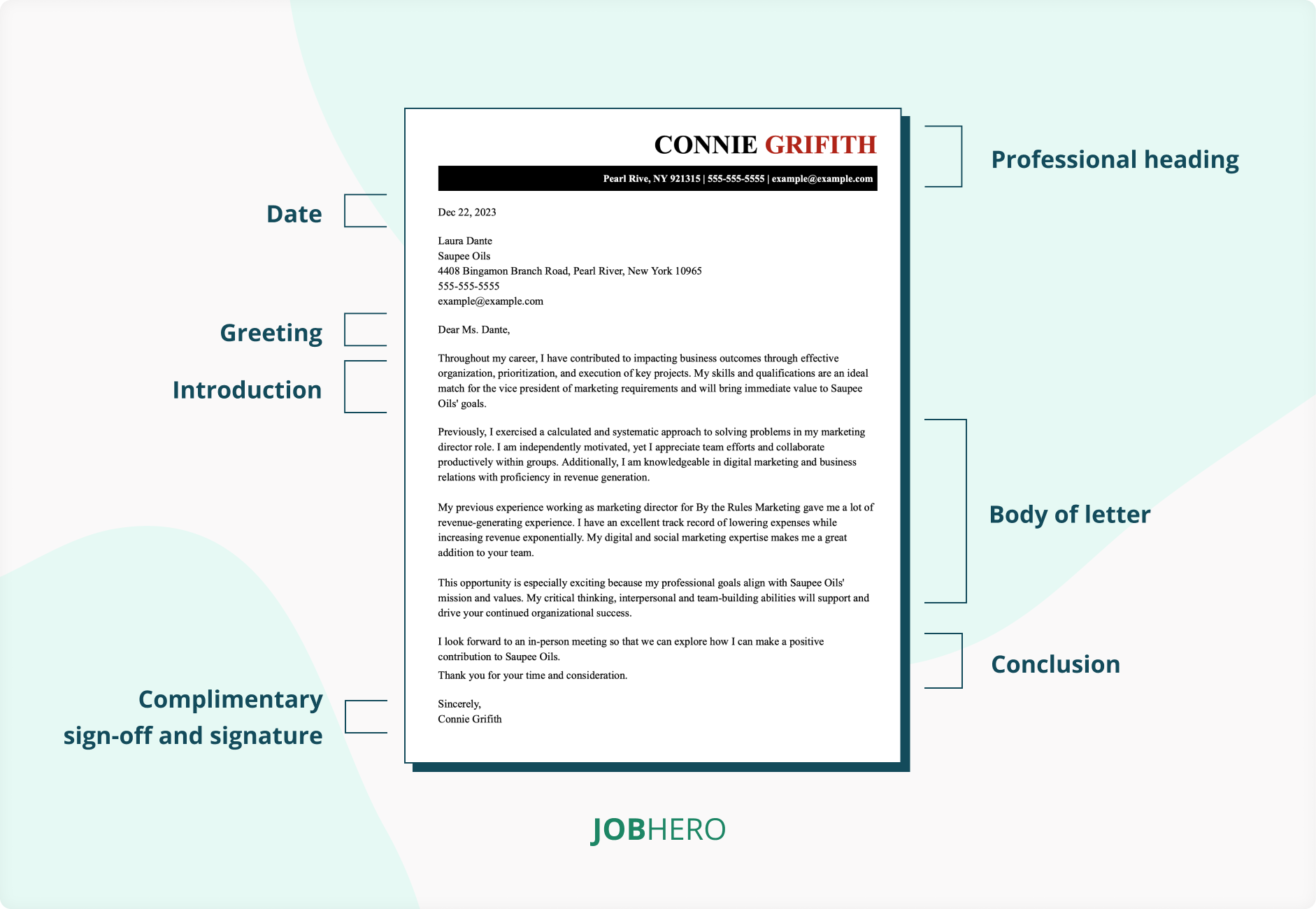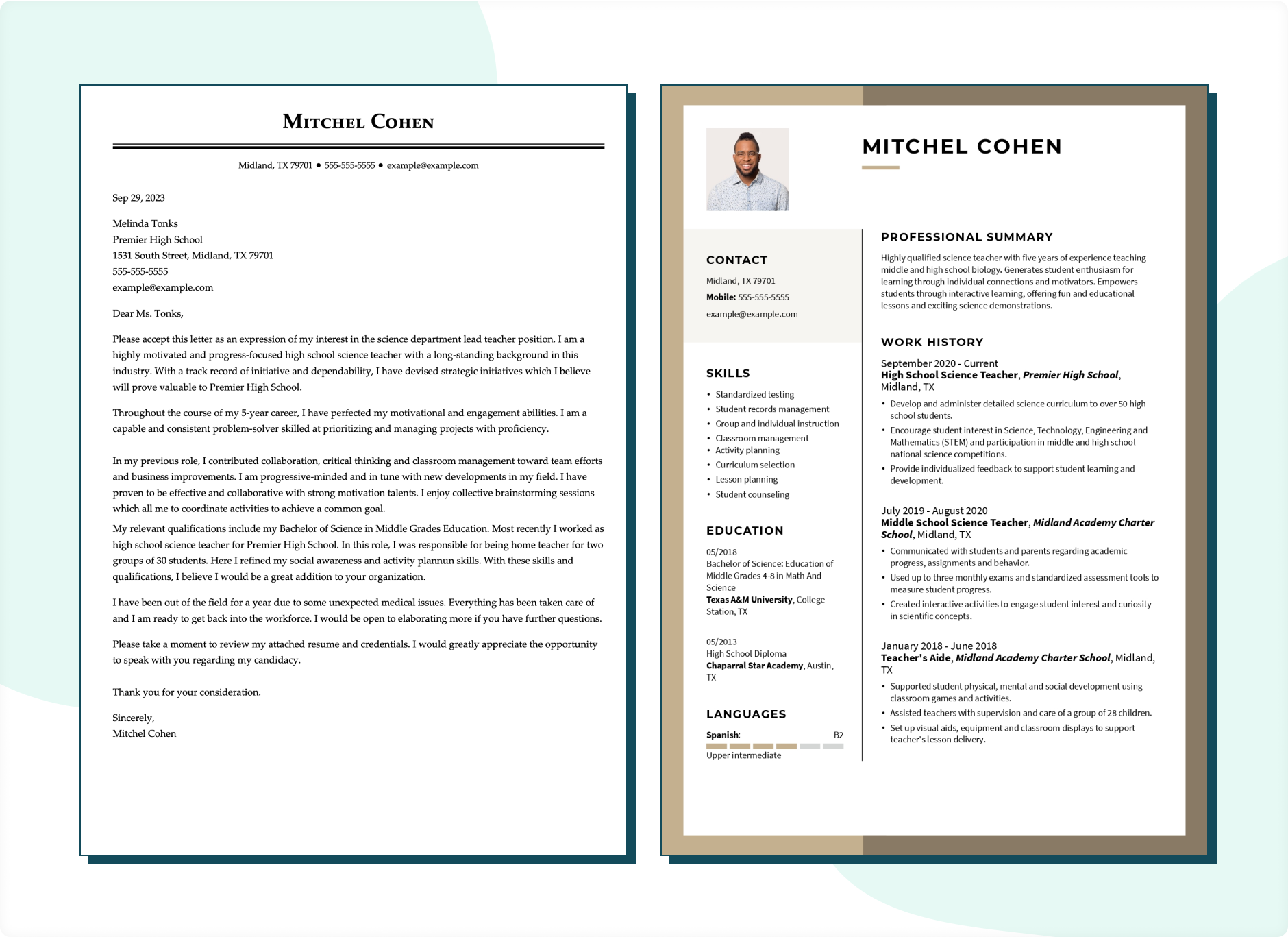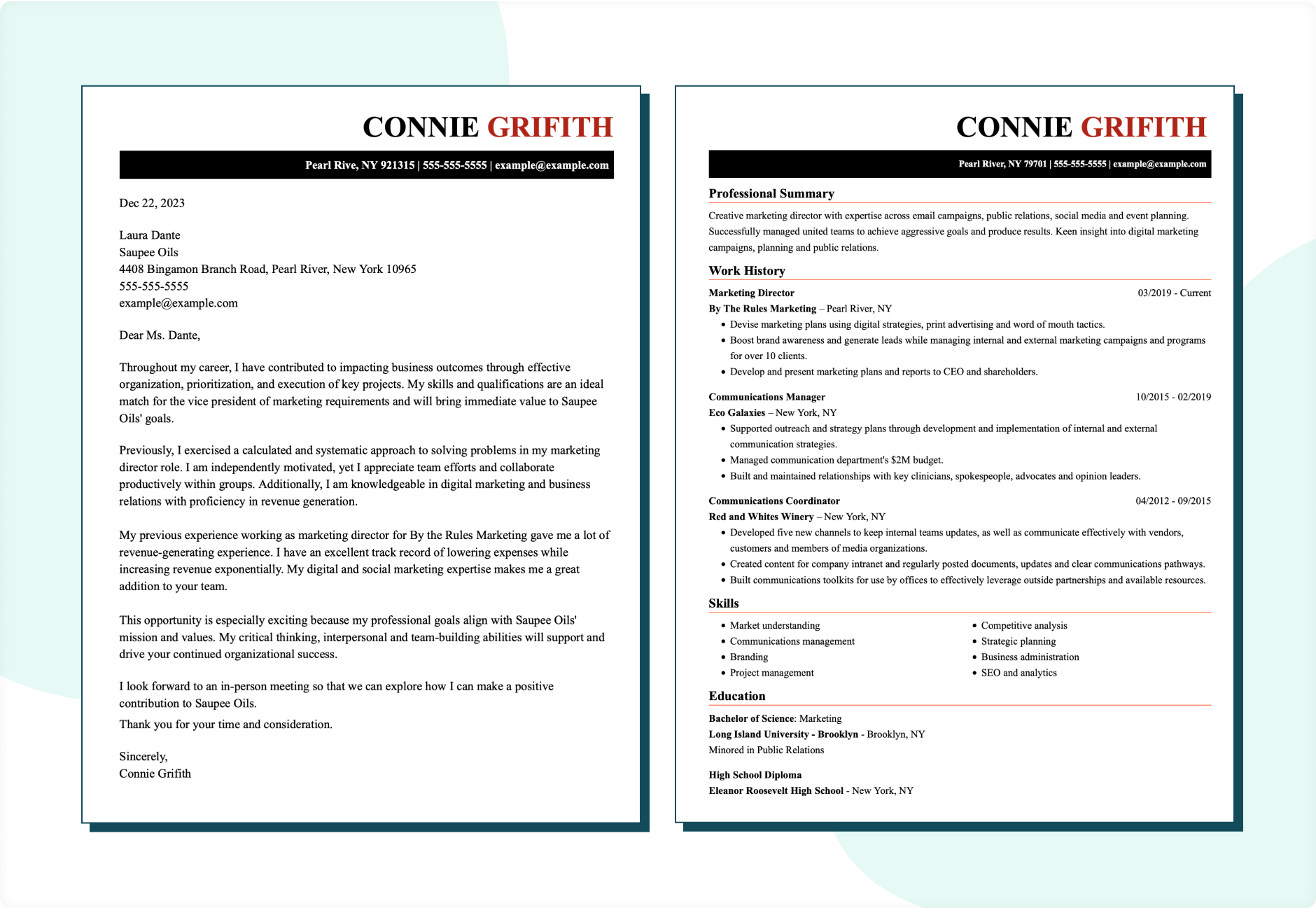- Featured in:
How to Create a Professional
Cover Letter
A cover letter is a formal business letter that builds on and augments your resume. It’s an excellent opportunity to expand on the information in your resume and pique the interest of a potential employer!
Consider your resume a comprehensive summary of your skills, experience and accomplishments. Your cover letter builds on one or two specific career skills and uses evidence-backed information to prove yourself as a potential hiring candidate for an open job.
Here are the standard sections of a cover letter:
1. How to make a cover letter header
According to the Purdue Online Writing Lab, a business letter includes your name, mailing address and the recipient’s contact information. However, you’re probably submitting your cover letter and resume via email or an online application portal — this modern method of application forgoes your typical mailing address in favor of your full name, phone number, professional email address and your current city and state. We recommend creating a dedicated professional email address for online applications, so you see all job-related responses.
PRO TIP:
Give your cover letter a professional pop by ensuring your header layout and design match your resume. Our Cover Letter Builder features a complementary Resume Builder with matching templates.
As for the recipient’s contact information, you’ll want to include the hiring manager’s full name, job title, company name and work address. This requires a little extra research. There are three ways to find this information:
Scan the job posting: Carefully review the job description. Not only will the posting include resume keywords that highlight the most desired skills for the job, but it may include the hiring manager’s name and contact information.
Search the company directory: If the job advertisement doesn’t feature the name of the hiring point person, you’ll need to do a little research. Find out which department or office the open job is based in and use that information to identify the head of that department.
Use an honorific department title: If you can’t find the name of a recruiter, HR professional or department head, you can opt for a generic line such as “Dear Hiring Manager.” Reserve this greeting as a last resort — it can come off as impersonal and low-effort.
2. Add a date and salutation to your cover letter
Add a date along with a formal greeting to the hiring manager. A recent date indicates that this letter was up-to-date, and showcasing the hiring manager’s name shows sincere interest in the role due to your research and attention to detail.
Example of acceptable date formats:
- Jan. 1, 2000
- January 1st
- 1/1/2000
Examples of good cover letter greetings:
- Dear [Recipient’s name],
- Dear [Job Title]’s Hiring Manager,
- Dear Head of [Job Title’s Department],
- Dear [Departement] Recruiter,
- Dear [Recruiter’s Name],
- Greetings,
Examples of poor, impersonal salutations:
- To whom it may concern,
- Hi,
- S’up,
3. How to introduce your interest and qualifications
Your opening statement must capture the recruiter’s attention to incite them to read the rest of your cover letter. Your introduction should include the following information:
- Who you are as a professional
- What specific job title you’re applying for
- Why you want to join the company
- How your skills and experience make you a good fit
- Where you learned about the position
Check out these sample introductions:
“Your advertisement in the Eureka Times-Standard for a building maintenance manager position at the Harborside Apartment Complex caught my eye as a perfect fit for my skills. I’m an experienced carpenter specializing in plumbing and electrical maintenance and repair. I can be on hand to address residents’ maintenance and upkeep requests.”
This job seeker quickly mentions where they saw the advertisement, what position they’re applying to, and which skills they possess that would make them an effective building manager.
“As a professional with excellent lesson planning and curriculum adoption skills, I was happy to see and apply for the experienced language arts teacher at Marshall School District post via the HiredBoard website. Your school’s charter statement aligns with my beliefs about how students can succeed, reassuring me that I would be well-placed among your staff and students.”
This educational job seeker quickly advertises their classroom leadership skills and alignment with the school’s mission statement, indicating they’d be a good culture fit and an asset to the school.
“Your former VP of Marketing and colleague, Alison Dalio, recommended that I contact you for your recent open copywriter position. I have over seven years of experience in email marketing, including overseeing email campaigns with 72% increased conversion rates, increasing mailing lists and identifying potential consumer bases. I’ve no doubt I can create similar results for your company through engaging content that keeps your users clicking.”
This marketing job seeker leverages their professional network to find an open job opportunity. They quickly share a company reference with a shared colleague to create a connection with the hiring manager.
“One of your recruiters, Antonia Blanca, reached out to me via LinkedIn to notify me about your company’s opening for a senior-level accountant, and I’m very interested. I have led my current employer to an overall 18% reduction in company overhead over the past two years, speaking to the quality of my skills in budget analysis and market research. I want to bring about the same financial restructuring your company currently seeks.”
This job seeker uses a combination of accomplishments backed by statistical proof and a personal reference from the company’s hiring department to introduce themselves.
4. How to write a cover letter for a job: tailor the body paragraphs
The body of your cover letter is the trickiest part. You need to emphasize your experience using practical examples of your career accomplishments within a concise space. Most hiring managers review dozens to hundreds of applications. Here’s how to write a cover letter with a short, direct body section.
1Decide which qualifications you wish to feature.
Your cover letter tells a story about you as a job candidate. Describe your skills and explain why you meet the company’s demands.
Pull together as many details as possible about this accomplishment, such as cost-to-profit analysis, increased engagement, positive client feedback or on-time performance. Once you have this master list of information, you can pick and choose the data to showcase based on the advertised needs of the job.
Tailor your cover letter to each job, as you’ll see with the following job seekers.
2Respond to the needs of the job.
This retail job seeker understands the importance of meeting quarterly budgets to maintain a profitable inventory and a well-staffed store. They highlight their fiscal responsibility, budgeting experience, staff training, store-dressing and customer-first experience to highlight their qualifications as a site manager.
“As a store merchandising manager, I excelled in attention to detail. Every inventory we performed was on-point to the fiscal dollar. This also carried through to every store element, from how employees dressed to the frequency with which we adjusted displays and the courtesy shown to customers. It’s the details where people find value, and it serves as my guiding philosophy as a manager and the kind of comprehensive work I hope to bring to Grayson’s Boutique.”
3Mention your notable career achievements.
This job seeker highlights their business acumen and collaborative skills by showing how they identified key profit-loss practices, worked with various departments to find alternate vendors, and implemented a streamlined on-site process to reduce shipping costs and increase company profits.
“My tenure as the head accountant at Brigtsen’s Lighting led to a multistep process that increased company revenue over two years by 34%. My initial analysis uncovered that our most considerable losses came from inefficient shipping practices. However, once we found more cost-effective logistics solutions, I spearheaded an audit of every element of our products and operations. From there, we minimized losses by working cross-functionally with production managers to source cheaper packaging materials. We maintained a high-quality product through these creative solutions while increasing efficiency and reducing costs.”
4Use the STAR method.
“While working as marketing manager for Browne Agency, a client approached us with a unique problem: their wristwatch brand had zero brand awareness in the U.S. I led several brainstorming sessions with our creative team and implemented our strategy through connections in the talent industry, managing to feature the product with top social media influencers. The result: Not only did it boost brand recognition, but also sales in the U.S. market increased by 22%.”
This job seeker knows how to write a good cover letter by bringing the Situation, Task, Action, Result, or STAR interview method, to their cover letter. They preempt any questions the hiring manager may have by demonstrating the value and challenges they’ve overcome.
5Use strategic formatting choices to highlight essential information.
We mentioned that you need to keep the body of your cover letter short and direct to retain a hiring manager’s attention, but you can use design to help highlight your skills and qualifications. You can learn more from our cover letter formats article, but our favorite formatting tricks include the following:
Bulleted lists: The formulaic structure matches your resume and makes it easy for readers to scan your document and find vital information quickly.
Here’s an example of how to make a cover letter with bullet points:
Working as an administrative assistant for two different genetic testing clinics has honed my skills in the following areas:
- Professional phone manner, customer service and oral communication.
- Fluency in Office Suite, Google Workspace, Slack, Asana, Jira and Trello programs.
- Office hardware knowledge and problem-solving.
- Multitasking patient processing duties with phone reception, data entry and office management.
- Typing speed of 75 wpm.
- Great sense of teamwork and boosting office morale.
Use bullet entries sparingly — an overreliance on them can strip away your voice. An effective cover letter highlights your skills and gives hiring managers insight into your thoughts and personality.
You can counteract this by combining full sentences backed with skills-based bullet entries like the following job seeker. They cover their collaborative work style before listing their technical skills:
Overall, as a web developer, I spent over two years at McClusky Developers working to perfect my base skills. Furthering my professional education by working for Beastcorp, I began asserting myself as a leader and more of a presence in our group meetings. I’ve earned a reputation as an expert when it comes to the following areas:
- C++ and Java fluency.
- Debugging pages without a given error code structure.
- Increasing performance and stability through troubleshooting.
5. How to write an application letter’s concluding paragraph
This final paragraph needs to reassure hiring managers of three things:
Your interest in the open job.
Your suitability for the job.
An invitation to reconnect via interview.
“Thank you so much for your time in reviewing my application. I attached my design portfolio and my resume so that you can see examples of my work. Again, I’m very excited about this opportunity, so please let me know if we can meet and discuss it further.”
Use bullet entries sparingly — an overreliance on them can strip away your voice. An effective cover letter highlights your skills and gives hiring managers insight into your thoughts and personality.
“Thank you for reviewing my application. I attached my design portfolio and resume so you can see my work samples. Feel free to contact me via xxx-xxx-xxxx or email this Wednesday and Thursday during normal business hours — I look forward to meeting and discussing this design opportunity further.”
As we mentioned before, hiring managers sift through a lot of applications. Adding your contact information and availability to the end of your letter saves a hiring manager the logistical time and energy it takes to find an interview time that works for both parties.
6. Finish your letter with a sign-off and signature
Conclude your cover letter with a formal farewell and typed signature. Appropriate sign-offs could include:
- Thank you for your time,
- Thank you,
- Best,
- Kind regards,
Add a Matching Resume to Your
Cover Letter
We mentioned that a cover letter is a supplemental document that supports and expands on your resume. You can use matching templates to give your application a seamless, cohesive look. Well-written, spell-checked and cohesive documents can show you have strong attention to detail.
Let’s see how a pair of mismatched documents compare to a set of matching application materials.
Mismatched
If you’re willing to dedicate such attention and care to a job you don’t have, this can really influence a hiring manager to give you strong consideration. You can compare the following two job seekers to see how matching templates can boost your application. See our complete collection of resume and cover letter templates.
Matching
How to Write a Cover Letter FAQ
How do you write a good cover letter?
You can learn how to make a good cover letter using various tools. We like to use the following cover letter aides to help us write meaningful and effective cover letters.
- Cover letter examples: Every job and industry is different — these cover letter examples help you identify what skills and experiences are necessary to succeed in a role. Pro tip: these professional samples give you exclusive access to insider terms and shorthands related to unique industries.
- Cover letter templates: We cover helpful formatting rules that can help you write a well-structured cover letter, but these pre-formatted templates reduce the amount of time and work you need with straightforward, fill-in-the-blank designs
- Cover Letter Builder: What’s better than writing a cover letter from scratch than using an AI-powered tool to help you write a first draft? Our builder suggests pre-written templates based on your experience and the most frequently requested skills for your goal job.
How do you write a cover letter if you don’t have experience?
To learn how to write a cover letter with no experience, we must define expertise. Even if you never had a formal job, you have job-relevant experience thanks to school, family commitments or community service. If you took college courses, you already know how to keep to a schedule and complete tasks within a specified time period — so let’s discuss how we translate that experience into job-related skills.
To write an effective cover letter with no formal job experience, focus on transferable skills like:
- Teamwork includes group projects with high grades or after-school sports with favorable win rates.
- Time management is related to juggling multiple classes or after-school activities.
- Customer service related to volunteering for bake sales and fundraising.
- Basic math skills such as math courses or cashing handling experience.
- Physical stamina related to P.E. or after-school sports.
- Tutoring skills related to your academic courses and volunteering.
How can you make your cover letter stand out?
Let’s discuss how to make your cover letter stand out — you want hiring managers to know that you carefully read and researched the needs of the job. To do this, review the job description carefully and look for “resume keywords.” You can find these keywords by looking for repeated phrases or highlighted responsibilities throughout the job advertisement.
These words or phrases are used by applicant tracking systems (ATS) and hiring managers to rate applicants — strategically placing them throughout your cover letter and resume reassures hiring managers that you carefully read the descriptions and thoughtfully consider what qualifications you feature.
How do you write a cover letter for an internship?
You might wonder how to write a cover letter for an internship. To write an effective internship cover letter, provide transferable skills based on your academic training or previous experience.
For example, this second-year business student advertises their data analysis and business strategy knowledge to conceptualize a potential marketing campaign their employer might use. This strategy demonstrates how this intern applicant is already applying their education training to benefit their potential employer.
“As a business management student, I am excited to apply for New Wayve’s summer internship program. I look forward to applying my data analysis knowledge and developing a business strategy based on the exciting developments you and your current product team are creating. I look forward to working with your team and my fellow summer associates to draft an aggressive product marketing campaign you can adopt soon.”
Can using a cover letter builder help your job application?
Our Cover Letter Builder can help your complete a job application by:
- Saving time with pre-formatted and professionally designed templates.
- Helping you adopt a professional tone with pre-written text templates.
- Adopting the professional voice of fellow job seekers.
- Suggesting unique skills and responsibilities based on your experience.
- Prioritizing job-relevant skills and accomplishments based on current hiring trends.
- Helping you write a matching resume.






